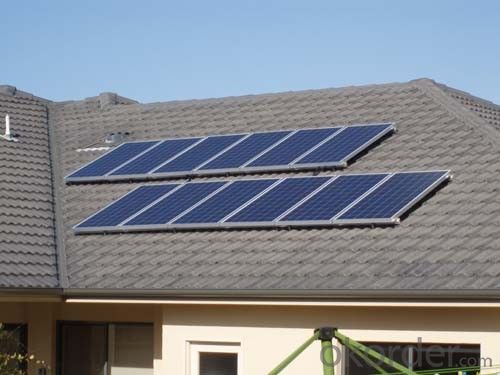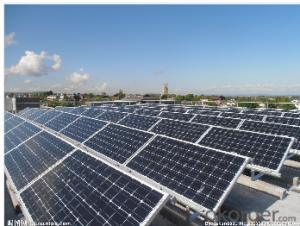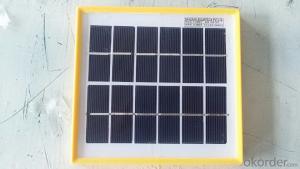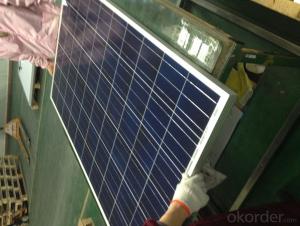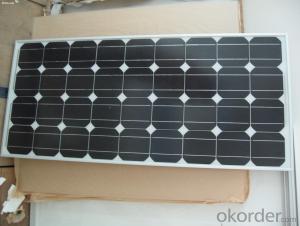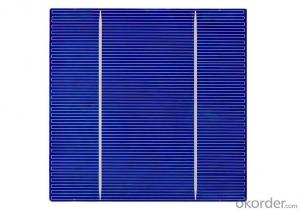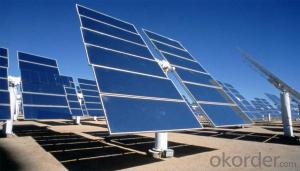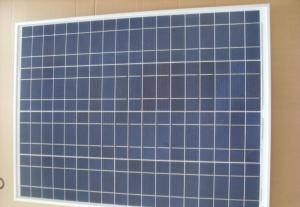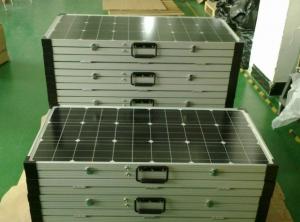Solar City High Efficiency 3w to 340w Solar Panels with Low Price
- Loading Port:
- Shanghai
- Payment Terms:
- TT OR LC
- Min Order Qty:
- 1000 watt
- Supply Capability:
- 1000000 watt/month
OKorder Service Pledge
OKorder Financial Service
You Might Also Like
Specification
Product Description
High Efficiency 3W to 340W Solar Panel with bosch solar cells
Our solar panel has always been a best seller. It features A-grade high efficiency monocrystalline solar cells and is assembled in compliance with Sungold's unique quality standards. The solar panel not only is a preferred option for residential systems, but also proved to be a great match for commercial, large-scale and standalone applications.
Features
1.High reliability with guaranteed -3% to +5% power output tolerance, ensuring return on investment
2.High conversion efficiency based on leading innovative photovoltaic technologies
3.Withstands high wind-pressure and snow load, and extreme temperature variations
4.Attractive appearanceUnique frame design, high mechanical strength, and easy Installation
Material
1.Solar cell-conversion efficiency of solar cell: 24%-17%
2.Front glass-3.2mm, high transmission, low iron, tempered glass
3.EVA-excellent anti-aging resistance
4.TPT-hot seal made of flame resistance
5.Flame-reinfored anodixed aluminum flame
6.Junction box-Ip54 rated and Ip65 rated, high quality, with diode protection
Warranty
1) 10 years for material & workmanship;
2) 10 years for 90% power output;
3) 20 ears for 80% power output.
Packaging & Delivery
1. Packaging Detail: 2PCS/CARTON; 504PCS/40'; 520PCS/40'H
2. Delivery Detail: 10-15 days after receiving deposit
Customer Stories & Applications
1. Any large or small on-grid or off-grid solar power stations.
2. Commercial and industrial building roof-top systems
3. Resident systems.
4. Any commercial or industrial ground mounting systems 5. solar television, Solar power, solar heater, solar lights, Highway solar street lamp, solar car / electric vehicles, satellites, spacecraft, space solar power plant, energy saving lamp, the field of environmental protection.
WHY US?
1. We have our own production line of solar cells.
2. Our solar panels are good quality with OEM service.
Our products are backed by an industry standard 5/10/25 warranty to assure the longevitiy of your system. Not only this, we assure the quality of our modules with 100% infrared scanning to go with our standard quality assurance procedures. Depending on the availability by your location, we may also be able to offer liability insurance coverage for our products.
APPLICATION
| Place of Origin: | Guangdong, China (Mainland) |
| Material: | monocrystalline silicon |
| Max. Power: | 320W |
| Conversion efficiency: | 18.44% |
| Module size (mm): | 992*1950*50mm |
| Cell Type | 156*156/6*12 |
| Nominal voltage(V): | 36.8 |
| Nominal current (A): | 8.7 |
| Open circuit voltage (Voc): | 45.4 |
| Short cirsuit current(Isc): | 9.39 |
| Power tolerance: | -3%to+5% |
| NOCT: | 45± 2%/degree |
| Temperature coefficient of Voc: | -0.34%/degree |
| Temperature coefficient of Isc: | 0.017%/degree |
| Temperature coefficient of Pmax: | -0.48%/degree |
| Operating temperature: | -40/degree to+85/degree |
| Certifications | ISO 9001 TUV CE RoHS |
| Maximum system voltage: | 1000V DC, 600V |
- Q: How do solar panels affect the overall resilience of a building?
- Solar panels can significantly enhance the overall resilience of a building. By generating clean and renewable energy, they reduce dependence on traditional power grids, making the building less vulnerable to power outages or disruptions. Additionally, solar panels can provide a reliable source of electricity during emergencies, ensuring critical systems like lighting or communication remain operational. The energy independence offered by solar panels enhances the building's ability to withstand and recover from various crises, ultimately improving its overall resilience.
- Q: Can solar panels be installed on outdoor lighting fixtures?
- Yes, solar panels can be installed on outdoor lighting fixtures. In fact, many outdoor lighting fixtures, such as solar-powered garden lights or street lights, come with built-in solar panels that allow them to harness energy from the sun to power the lights. This eliminates the need for electrical wiring and makes them more energy-efficient and environmentally friendly.
- Q: What are the financial benefits of installing solar panels?
- Installing solar panels can provide numerous financial benefits. Firstly, solar panels can significantly reduce or eliminate monthly electricity bills as they generate free and sustainable electricity from the sun. This can result in substantial long-term savings, especially in areas with high electricity rates. Moreover, solar panels often have a long lifespan, making them a worthwhile investment. Additionally, many governments and utility companies offer financial incentives such as tax credits, rebates, and net metering programs, further reducing the upfront cost and maximizing the financial return. Lastly, solar panels can increase the value of a property, making it more attractive to potential buyers and potentially yielding a higher resale value. Overall, by installing solar panels, individuals can save money, increase their property value, and contribute to a more sustainable future.
- Q: Photosynthesis is fairly inefficient, but efficient enough to power all life on earth.
- One of the primary reasons solar cells are made of silicon is that the bandgap energy of silicon happens to be nearly equal to the energy of visible light, which is the major portion of energy emitted by the sun. Therefore, silicon is the ideal substance to fabricate solar cells with.
- Q: I want to buy a solar panel kit to run my central AC unit. it is a 3 ton unit. Can I do this? The electric rates in the Chicago area are skyrocketing and I can't keep paying 350 dollar electric bills during the spring and summer months
- I know that in Texas we wouldn't even try to run an air-conditioner on a generator without at least a 6,000 watt generator and we would prefer a 0,000 watt generator. The calculator on the Kohler website says it'll be 7,500 watts. At $5 per watt to install a solar photovoltaic system and assuming you also need to run it through the night and taking into account that an inverter can be as bad as 60% efficient, you're talking about $87,500 just to run your AC for 25 years. The first step in going solar is to significantly reduce your energy use. You're not going to maintain your current energy use on solar, at least not cost effectively. If you did want to run an AC on solar power, you may want to look at absorption air conditioning and use evacuated tube solar thermal collectors instead but don't expect it to be cheap and it usually only augments the use of natural gas in the absorption chiller.
- Q: I have a solar panel 7.5V .25W 50mah, connect 2 in parallel to power a RC boat. The boat use to run on 6cell battery pack - 7.2V 800Mah.The dc motor requirement based on the provided battery pack, i assume would be 7.2V and rated at (7.2V * .8Amp) = 2.96 Watt.Would two of my solar panels run this DC motor ?are my calculations or understanding correct ?do lend a hand dear ''world''
- Wood? Steel tubing could be a lot lighter. Use the hardest narrowest tires you can find bicycle wheels and tires would work nicely and they can be had with really light disc breaks. As for a motor a golf cart motor is made to order. You can get an old electric golf cart and have almost all the parts you will need. Hell cover the roof of the cart with photo voltaic and have a ball. Note I stress weight savings as weight will cost you energy and with photos you won't have much to spare. You will need a battery pac of some sort lithium are a better choice than lead acid. there is a ton more to consider good luck with your project.
- Q: I have a cabin in the woods and need more light. I do have enough sun but I was wondering how or where do I get a solar panel to lead to a power outlet? In a perfect world I would like to get a solar panel with a connecting wire to an outlet or something so I could power a small TV. I know its hard enough but can I get that pre-made? Or even lastly should I look at wind power consider I would like this to be under $500? Thank you for putting up with this bundle of questions.
- A typical solar panel will deliver 50 watts of power in the form of 24 volts DC. You need 20 volts AC. So here is what it takes: Since you will need at least 200 watts to do a small TV, you need four solar panels, and a solar controller. Then you need a 24 volt solar type battery to load the output of the panels. Next you need an inverter. This is a device that changes 24 volts DC into 20 volts AC, which you can wire to a standard outlet for the TV set. Solar panels cost around $6 per watt of power. 200 X $6 = $200 Solar Controller will cost around $50 The battery will cost around $00 The inverter will cost around $200 You could get by with less than 200 watts of solar panels if you just let it charge the battery all day and only use the TV for an hour or two in the evening with the TV running on the inverter which is powered by the battery. The link is for a similar system ready to go. Wind is not a viable option.
- Q: How can I know the right type of solar panel to choose for my small village house in Africa?
- The power output of a solar panel uses a formula to determine kilowatts produced per hour per square meter per day. This calculation is important because, if you plan to install a solar power system for your home, you will want to know how many solar panels will be needed. To calculate solar power requirements correctly, you need to gather the data that is needed for the calculation. First you have to find the average amount of solar radiation available for your area. You can use a solar radiation chart. This can range from a 4 to a 7 depending on the area you live in. Write the number down on a piece of paper and indicate it with the letters RA. Next is determine the amount of electricity that you use daily. Add the kilowatt-hours used per month from your utility bill. Multiply this number by ,000 to get the watt hours in a month. Divide the total by 30 for the amount of electricity you use daily. Write this number down and indicate it with the letters DE. Determine the percentage of your home that you want to power with the solar power system. Write this number down and indicate it with the letter P. Determine the system inefficiency factor for the solar power system. You should be able to find this on the brochure for the system or from the manufacturer's web site. Write this number down and indicate it by the letter I. Determine the power or yield that is required for your home. Use the equation P = I x (DE x P) / RA to find the power requirements in kWh. Divide the number from Step 5 by the peak wattage for a single solar panel to determine the number of panels you will need for your home. Goodluck! :)
- Q: How do solar panels withstand hail and other extreme weather conditions?
- Solar panels are designed to be durable and withstand various weather conditions, including hail and extreme weather. They are typically made with tempered glass, which is highly resistant to impacts from hail and other debris. Additionally, the solar cells are encapsulated in a protective layer of materials such as ethylene-vinyl acetate (EVA) and fluoropolymer, which provide further protection against weather elements. The structural design and mounting systems also ensure that solar panels are securely installed to withstand strong winds. Overall, the combination of robust materials and careful construction allows solar panels to withstand hail and other extreme weather conditions.
- Q: Can solar panels be installed on a hospital or medical facility?
- Yes, solar panels can be installed on a hospital or medical facility. In fact, many hospitals and medical facilities have already adopted solar energy to reduce their carbon footprint and lower energy costs. Solar panels can be installed on rooftops or on the ground surrounding the facility, providing clean and sustainable energy to power the facility's operations.
Send your message to us
Solar City High Efficiency 3w to 340w Solar Panels with Low Price
- Loading Port:
- Shanghai
- Payment Terms:
- TT OR LC
- Min Order Qty:
- 1000 watt
- Supply Capability:
- 1000000 watt/month
OKorder Service Pledge
OKorder Financial Service
Similar products
Hot products
Hot Searches
Related keywords



